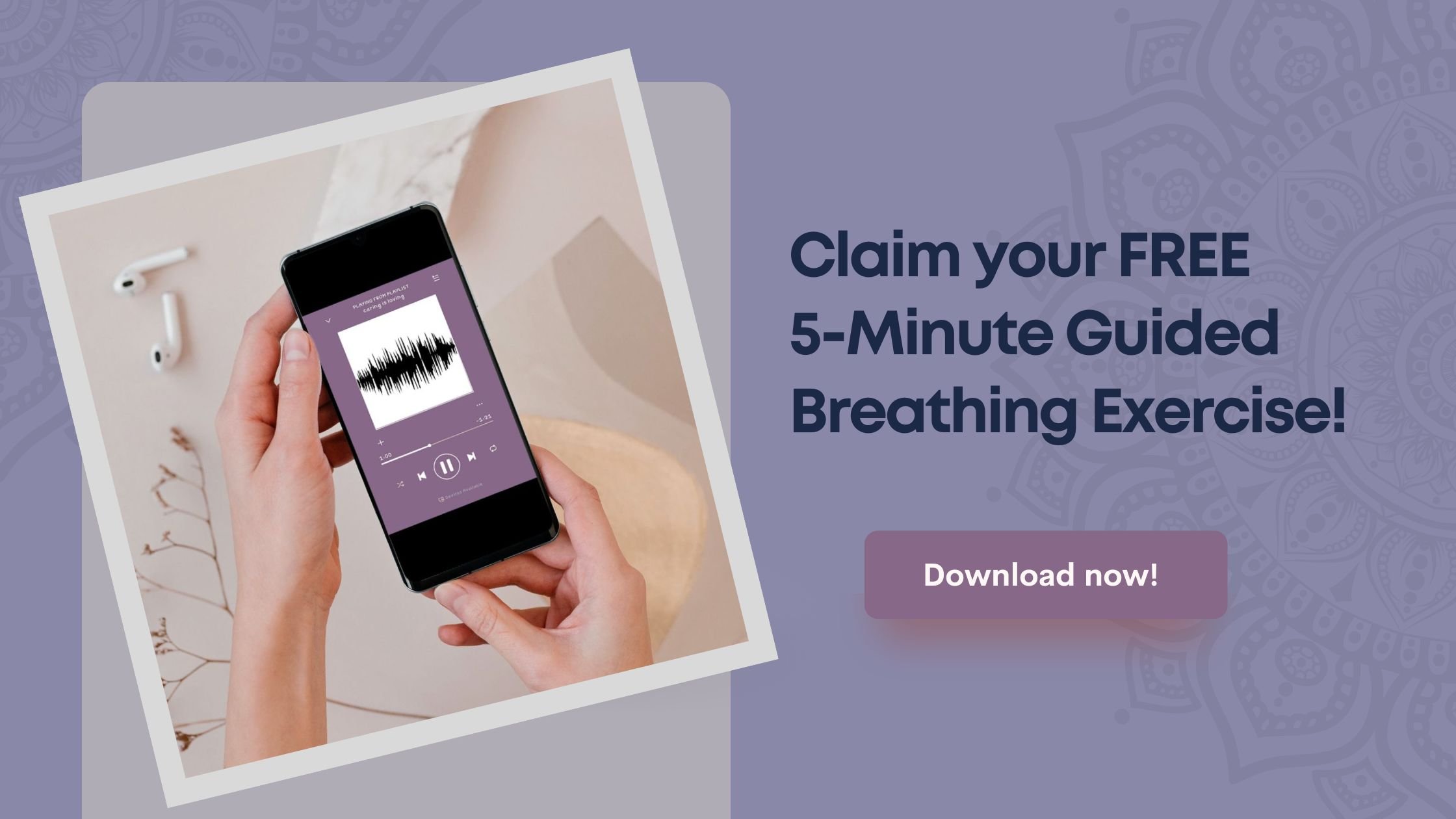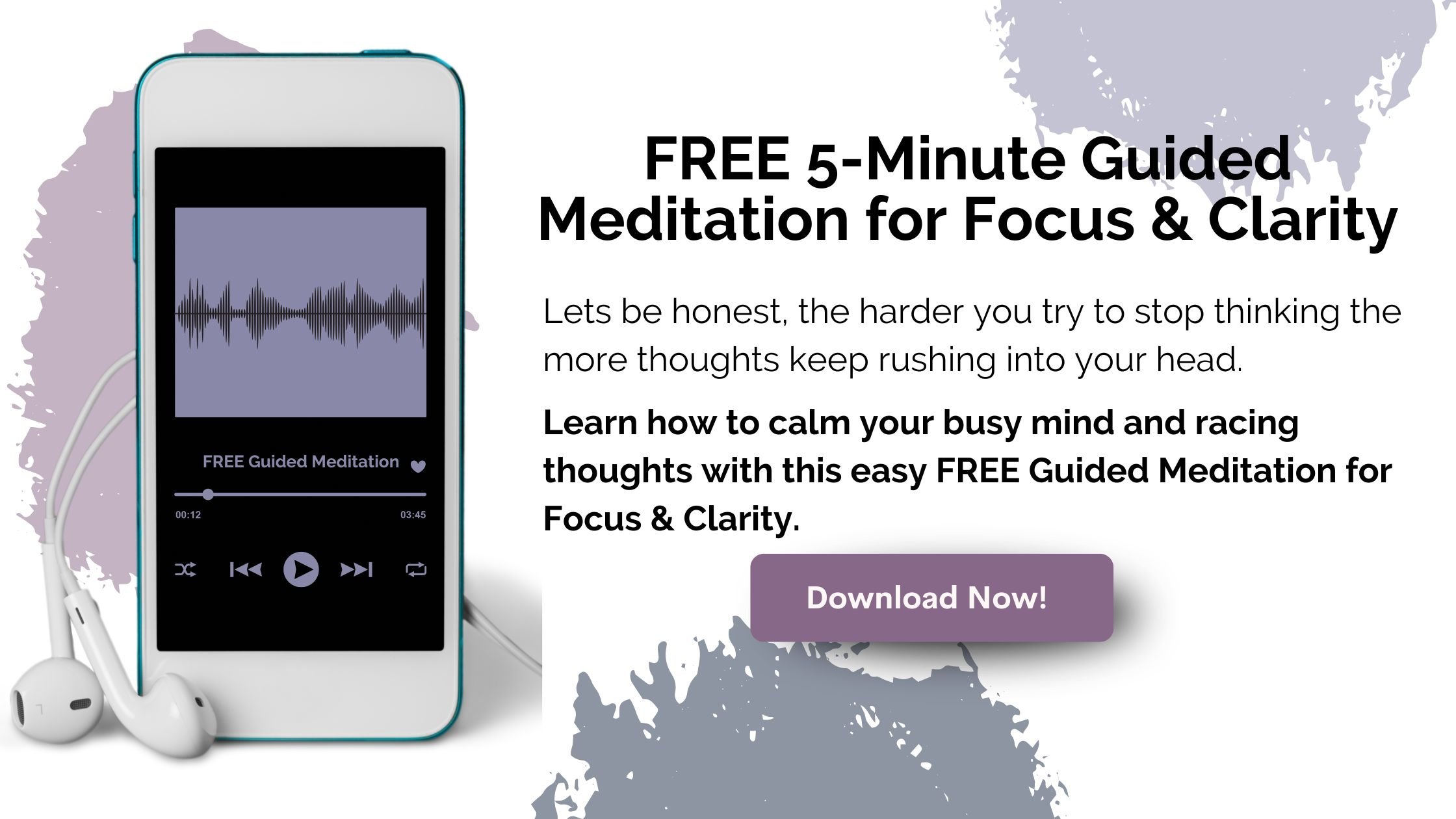Breathwork vs Meditation: Can’t focus during meditation? Try breathwork

Key Takeaway Points
- Both breathwork & meditation help with focus and concentration, but they go about it in different ways.
- Breathwork uses its direct connection with the nervous system to trigger a calming response.
- Breathwork is great for a fast calming response, can be done anytime anywhere, and can be easier to learn.
- Meditation works by activating the parasympathetic nervous system.
- Meditation is useful to build our ability to concentrate and focus over time.
When it comes to finding focus and stillness, there are many paths that one can take. Breathwork and meditation are both practices that can help to improve focus and concentration. But which is better breathwork vs meditation? For some people, meditation can be difficult to maintain focus during. If you find yourself struggling to focus during meditation, breathwork may be a better option for you. Breathwork is a practice that involves controlled breathing, and it has been shown to be effective in reducing stress and anxiety.
On the other hand, meditation can help us to build our ability to focus in the long run, if you can hang in there. Meditation has been proven to help increase our capacity for focus, and also to help us manage stress. It isn’t always easy, but it can have big rewards in the end.
Both techniques help with focus and concentration, but they go about it in different ways. Breathwork helps us to focus by taking advantage of its direct connection to our autonomic nervous system, while meditation helps us to focus by building our brain’s ability to concentrate over time.
What is the difference between meditation and breathwork?
Breathwork is a powerful, direct way to hack the body’s nervous system. Breathwork can be easier to incorporate into your day than sitting still for a longer time meditating because many breathwork techniques can be practiced anytime or anywhere. It is also great for those days when we are feeling fatigued or mentally stressed, or those times when we just need a quick rescue technique to get through a stressful moment.
Meditation is a way of training the mind to focus, and it uses different techniques to achieve that goal. There is a vast array of ways to meditate, from sitting still with eyes closed to walking and chanting. Meditation can be done for longer periods than breathwork, and it can be done in groups or on your own.
One benefit of breathwork over meditation is that breathwork takes advantage of breathing’s direct connection to our autonomic nervous system. Often when we are extremely upset or stressed we can’t calm down our mind with meditation because our body has already gone into fight or flight mode. This is where breathwork has the advantage in providing stress relief when we are in crisis mode.
What is breathwork?
So, what is breathwork? Breathwork, also known as yoga breathing or pranayama, is simply learning techniques to control our breathing. Breathwork techniques modify the depth at which you breathe, how frequently you breathe, the rhythm of your breath, and your overall breathing patterns.
There are many different types of breathwork, but all involve paying attention to your breathing pattern and making adjustments as needed. For example, you might focus on deep belly breathing or count each inhale and exhale. The goal is to find a rhythm that works for you and helps you relax.
The benefits of breathwork
There are many benefits of breathwork. Some of the benefits are reducing stress, reducing anxiety, improving our focus, boosting digestion, improving sleep, and overall regulating our energy levels. The really cool thing about breathwork is that we can do this completely free anytime anywhere without the need for medications. It’s completely safe, easy to learn, and we can get reproducible predictable results every time.
Below are 10 of the most common benefits of starting a breathwork practice.
1. Breathwork for stress relief.
Breathwork is a great way to calm down, relieve stress and feel more relaxed. When you’re stressed, it’s common to hold your breath or breathe shallowly. When you breathe deeply and slowly, your body relaxes. It also brings more oxygen into your brain and helps calm down the nervous system.
2. Breathwork for sleep improvement
If you have trouble sleeping, breathwork can help you doze off. It s a great way to reduce stress and anxiety, which can make it easier to fall asleep. Breathing exercises help you fall asleep quickly and stay asleep longer.
3. Breathwork for Pain relief
Breathing deeply and slowly can help ease tension in your body and relieve pain. It also can help you relax enough to go to sleep, which is important if you have chronic pain.
4. Breathwork for Energy
This is probably my favorite! When you breathe well, you increase the efficiency of your breathing, you increase your blood oxygen, and you feel more energized!
5. Better posture and less back pain
Our breathing patterns are linked to our posture. When you breathe well, you will stand and move better. Breathing exercises can also improve the flexibility of your spine and help prevent neck and back pain.
6. Breathwork for mental focus.
Breathwork can help with thinking more clearly and making better decisions. Breathing exercises can help you think more clearly, make better decisions, and calm your emotions.
7. Breathwork for better athletic performance
Breathwork has been shown to improve breathing efficiency and blood oxygen levels. Breathing exercises can also improve endurance, strength and balance.
8. Breathwork for creativity
Our breathing patterns are linked to our creativity. When you are breathing well, you can think more clearly and come up with ideas.
9. Better quality of life
People who use breathing techniques generally feel better overall. It s a great way to reduce stress and anxiety so you can think more clearly, sleep better, and focus on the tasks at hand. All of these things add up to an overall better quality of life.
10. Breathwork Improves your overall health
It has been said that breathing is the foundation of life. Everything we do feeds on our breath, including digestion, circulation, elimination, and even reproduction.

The science of breathwork
Breathwork is such an effective practice because it takes advantage of the connection between breathing and our autonomic nervous system to hack our body’s stress response.
When most people think about the nervous system most people think of our sense of touch. But the portion of our nervous nervous system that we’re taking advantage of when we do breathwork is our autonomic nervous system, the part of our nervous system that is responsible for all the things that we’re not conscious of like our heartbeat, breathing, swallowing, and digestion. All the things that happen naturally throughout the day.
Breathing is something that you can very very easily control so we can use controlling our breathing like a key to unlock the door of our nervous system and cue a calming response. Breathwork activates our parasympathetic nervous system, the rest and digest portion of the nervous system that cues our bodies to relax.
Types of breathwork exercises
There are many different types of breathwork, but all of them involve using your breath to improve your health. In my breath coaching, I teach three different categories of breathing exercises. Each takes advantage of our nervous system in a different way to produce different results.
Energizing Breathwork Exercises
The first is an energizing category of breathing exercise. These breathing exercises have a more rapid rhythm, and they activate our sympathetic nervous system. They’re great to do when we’re waking up because they give us a natural boost of energy. These exercises tell our body it’s time to get up and go. They are also great to practice before exercise.
Balancing Breathwork Exercises
The next category of exercise I teach are balancing breathing exercises. We take deep balance breaths. This category of exercise balances our nervous system. If we’re feeling a little bit up and stressed, it will help regulate and bring us back down. If we’re feeling a bit down and sluggish, it’ll help bring us back up.
Tranquilizing Breathwork Exercises
The last category that I teach are tranquilizing breathing exercises. This is a very very slow controlled deep breath. This category activates our parasympathetic nervous system. It tells our bodies it’s time to down-regulate and relax. This type of exercise is great to do if we want to get ready for bed, or if we want to improve our digestion. Ice category practices are perfect to practice in the evening.
What is meditation?
Meditation is the practice of quieting the mind and training attention. The basic idea behind meditation is to quiet the mind and clear it of distracting thoughts. Meditation is a powerful tool to help us learn how to focus our attention, become more present, and experience life with clarity.
Meditation is a practice that enables us to separate ourselves from our thoughts and feelings. It allows us to have a separation between us and our thoughts. When we can separate ourselves from our thoughts we can start to feel more at ease and less stressed.
You can take a step back and observe those thoughts and feelings objectively without feeling the need to get upset. We can allow ourselves to just observe, become more analytical, and gain some insight and perspective.
Meditation is not a quick-fix, nor is it a magic bullet. It takes effort and practice to reap the benefits of meditation, the same way it takes time to build muscle.
The benefits of meditation
Meditation has been shown to have many benefits, both mental and physical. A regular meditation practice can help to improve focus, concentration, and attention span; it can also reduce stress, anxiety, and depression. In addition to the mental benefits, meditation has also been shown to improve physical health by reducing blood pressure, improving heart health, and boosting the immune system.
Meditation is a practice that requires you to sit quietly and focus on your breath. It costs nothing and takes only a few minutes each day to practice. Below are some of the many benefits of meditation.

1. Meditation to reduce stress levels
Meditation can help you reduce your stress levels. In one study, meditation was found to be as effective as exercise in reducing stress. People who meditate regularly report feeling more relaxed, less stressed, and more in control of their lives than non-meditators. As little as 15 minutes of meditation per day may significantly reduce stress, anxiety, and emotional disturbances.
2. Meditation for focus
Meditation can help improve your focus and concentration, leading to increased productivity. If you lead an active lifestyle, it can also help you perform better on the field or court.
3. Meditation for anxiety and depression
If you suffer from anxiety or depression, meditation can help you cope with your symptoms. In a study of patients with social anxiety disorder, researchers found that those who practiced meditation experienced less severe symptoms than those who didn’t practice it.
4. Meditation for better sleep
Meditation can help you sleep better. It calms your mind and helps you focus on the present moment rather than on worries. Meditation can help you fall asleep faster and stay asleep longer, which is great for your health.
5. Meditation to improve memory and brain function
The practice of meditation can help improve short-term memory, working memory, and processing speed in both children and adults. Meditation can also help improve brain function and increase gray matter volume in the hippocampus, which is important for learning and memory. Meditation has also been shown to help keep your brain young by slowing the decline in gray matter density that occurs with age.
6. Meditation boosts your immune system
Research suggests that meditation boosts our immune systems by increasing the production of antibodies that fight off viruses and bacteria. One study by researchers at the University of Wisconsin, Madison found that people who practiced Transcendental Meditation for six months had increased levels of antibodies to the flu virus.
7. Meditation for heart health
Meditation may help lower blood pressure and reduce the risk of heart disease. A recent study found that long-term meditators had a reduced risk of stroke, and heart attack compared to non-meditators. Studies have shown that even novice meditators experience a reduction in heart rate and blood pressure from just one session.
8. Meditation improves mood and mental health
Long-term meditators report feeling happier, less angry, and less stressed than non-meditators. Research also shows that meditators have increased levels of melatonin, a hormone associated with feelings of well-being.
9. Meditation improves productivity and creativity
Meditation can help you become more productive and creative. Studies have shown that meditators are more alert, attentive, focused and creative than non-meditators.
10. Meditation increases self-awareness
Meditation helps you become more aware of your thoughts, emotions, and behaviors. Long-term meditators are more in tune with themselves and their surroundings as a result of becoming more mindful, an essential quality for personal growth and happiness.
The science of meditation
The science of meditation and the nervous system is a mind-blowing topic. The nervous system is the master control center for the body and it regulates all of the body’s functions. Meditation has been shown to be an effective way to calm the mind and body, and it can also help to improve the functioning of the nervous system.
Meditation works by affecting our autonomic nervous system. The autonomic nervous system has two main branches: the sympathetic nervous system and the parasympathetic nervous system.
The sympathetic nervous system
The sympathetic nervous system is activated when we are under stress. The sympathetic nervous system is mainly responsible for the flight or fight response, keeps us alert and awake when we’re stressed. It s also responsible for the arousal that helps us to react quickly when we’re in danger.
The parasympathetic nervous system
The parasympathetic nervous system, on the other hand, is responsible for the relaxation response and helps us to sleep and digest food. It s also called the rest-and-digest response.
By practicing meditation, you are essentially deactivating your sympathetic nervous system and turning on parasympathetic activity. The parasympathetic nervous system is responsible for the relaxing, calming and restorative effects of meditation. Meditation also helps to regulate our stress response by lowering our cortisol levels.
Types of meditation
There are many types of meditation, but the most common is visualization. Visualization meditation involves focusing on a mental image. Other types of meditation focus on a mantra, or a saying or phrase that is repeated over and over. Still, other types of meditation involve focusing on sensations in the body. There are many types of meditation that can help you manage stress.
One of the biggest obstacles during meditation is the constant battle against your wandering mind. Not all meditation techniques are created equal when it comes to this. Some are more helpful when just starting out or if you’re struggling with an overactive busy mind that’s racing. Don’t let this frustrate you there are meditation techniques that give your mind a mental anchor, and allow you to focus.
Below are three of my favorite meditation techniques you can try when you are feeling extremely distracted or when you just can’t get your busy thoughts to slow down.
1. Visualization meditation
Visualization meditation is a technique that uses a mental picture as the center of your focus. This type of meditation teaches you to focus on this mental image, rather than the stressful situation itself.
2. Mantra meditation
Mantra meditation is a technique that uses a word or phrase as the center of your focus. This type of meditation teaches you to focus on this word or a sound as a mental anchor to focus your mind.
3. Breathing meditation
Breathing meditation is a technique that uses the breath as the center of your focus. This type of meditation teaches you to focus on your breathing and how it feels going in and out of your body.
For more meditations to help build concentration and focus when you’re struggling to quiet your mental chatter check out my post Meditation Techniques: 6 Ways to Quiet Your Busy Mind.
So…What’s next?
If you want to start a regular meditation practice and want the need-to-know facts about meditation with a quick overview of the who, what, when, where, and why of meditation I have the perfect post to help you get started: Meditation Basics: The Who, What, When, Where & Why of Meditation.
If you’d like to start a regular breathwork practice and learn more pranayama, yoga breathing, and breathwork exercises check out my blog post Check out my article on 5 Yoga Breathing Exercises for Beginners: Easy Traditional Yoga Breathing Techniques for the perfect breathing exercises to get you started with your own regular conscious breathing practice to take control of your breathing.














